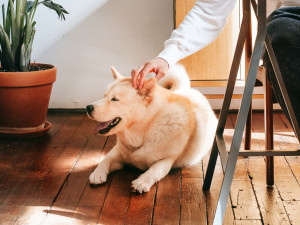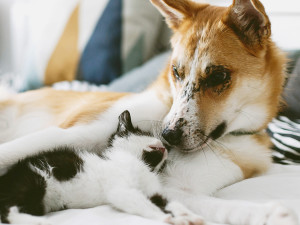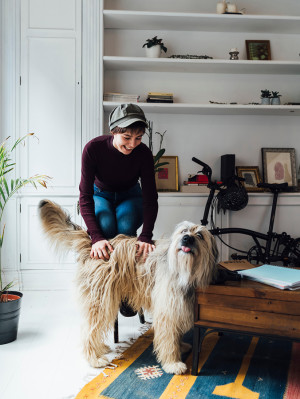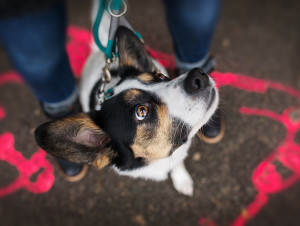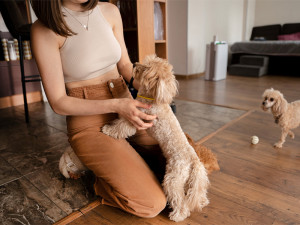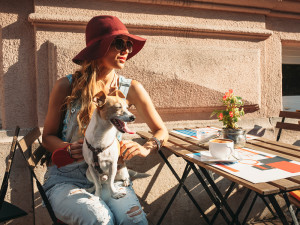How to Introduce Your New Dog to Your Kids
They’ll always remember their first childhood pet—this intro is just the beginning.

Share Article
Dogs can be the best (and cutest) playmates, sidekicks, and companions for kiddos. And together, they create an endless supply of Instagram-worthy moments. But you know that. That’s why you’re about to grow your family by one dog! The key to kids and dogs forming that one-of-a-kind friendship is establishing trust and respect. Your dog needs to know that they can feel safe and have fun around your child, and vice versa. How do you accomplish that? We asked a vet and a trainer to help show you the way.
Parents, it all starts with you.
From navigating the first introduction to monitoring your dog’s settling in period to everything that comes after, it’s up to you to set the tone. “First, the adults need to train themselves to do the right thing,” veterinarian Dr. Susannah Teran explains. “They are ultimately responsible for keeping everyone safe and creating a positive environment. Then, if the kids are old enough to understand and follow through, teach them the rules. After that, you can work on training the dog. That’s the mindset to have to be the most successful.”
Make sure your dog has a safe space.
Before your dog comes home, carve out a spot in the house that’s just for them. It could be a crate or a quiet corner of a room with a dog bed. Tell the kids that area is off-limits to them. (And folks, it’s off limits to you too.) Your dog will need to know that there’s a place they can always go when they need some alone time. We can all relate.
Take it slow.
Chances are, your kids are going to be very excited to meet your new pup. Your dog, however, may be feeling nervous or overwhelmed. “To start, have your dog on a leash and bring them into one room of the home,” recommends Valerie Peck, a certified dog trainer. “Let your dog explore the area slowly. Instead of your kids running up to the dog, wait until your dog chooses to approach them. If you have a baby, you can let the dog sniff some of the baby’s items to get them used to their scent.” While everyone is checking each other out, try to keep the vibe mellow. “If anyone starts getting wound up, it’s time to take a break. I also strongly recommend familiarizing yourself with dog body language. Understanding how your dog is reacting will help you make decisions about how to manage the introduction.”

Teach kids how to pet politely.
When first petting a dog, kids should avoid touching the dog’s head. Teach them instead to pet the dog on their side or back. It’s also important for kids to understand that petting a dog is a privilege. It’s up to the dog to decide if they want that kind of attention.
Peck recommends teaching kids the two-second rule: “Have your child pet the dog for two seconds, then stop and wait. If the dog comes back and wants more attention, your child can pet them again. But if the dog walks away or doesn’t re-engage, don’t force the interaction.” Here’s something that may be hard to hear: not every dog is a fan of petting. We know. It seems incomprehensible, but it’s true. “I always tell parents to show their kids other ways they can engage with the dog. Ideas include playing with toys, giving them treats, or being the one to set down their food dish.”
Try not to leave toys lying around.
Your dog may not want to share their toys with your kids. And your kids may not want to share theirs with the dog. And you probably don’t like stuff all over the floor, anyway. To avoid any confrontations (and tripping hazards), don’t leave toys lying around when no one is using them. But for the inevitable times when your dog does manage to get ahold of your kid’s favorite stuffed animal, “it’s beneficial to teach your dog commands such as ‘drop it’ and ‘leave it,’” Peck says. “When starting this training, I recommend having a treat jar in every room of the house. That way, you’ll have one on the ready whenever a teachable moment arises.”
Always, always supervise.
As your dog settles into their new home, they’ll start to feel more comfortable around your littles. Still, dogs and kids need adult supervision long after the initial introduction. “In my opinion, a baby should never be left alone with a dog, no matter how much confidence you have in your dog,” Dr. Teran says. “Same with a toddler. Despite your best efforts to teach good habits, toddlers and young children can’t be trusted to do what they are supposed to. It’s up to the parent to actively supervise when kids are interacting with the dog.”
This is pretty important stuff, but if you nail the intro, your kiddo and pup will be inseparable in no time.

Kate Sheofsky
Kate Sheofsky hails from San Francisco, where she developed a love of writing, Giants baseball, and houses she can’t afford. She currently lives in Portland, OR, and works as a freelance writer and content strategist. When not typing away on her laptop, she enjoys tooling around the city with her two rescue pups searching for tasty food and sunny patios.
Related articles
![dog and cat snuggling together]()
Animal House: How to Intro a New Dog to Your Other Pets
...Without turning your home into a circus.
![Happy young female student playing with hairy dog at home]()
You’ve Got Company: How to Cohabitate with a New Dog
Boundaries, right? But if they end up sleeping in bed, that’s cool, too.
![Stylish woman sitting on a bench with her Boston Terrier dog.]()
Here’s Why Your Dog Is Terrified of New People
And how to change this.
![Dog on leash sitting on a colorful street and looking attentive at their pet parent]()
How to Get Your Dog to Pay Attention to You
Here are some simple steps to pry your pup away from that one spot in the yard they’re obsessed with.
![A woman sitting on a floor playing with her dogs.]()
How to Know if Your Dog Has Imprinted on You
If they’re following you around like your shadow, there’s a reason for that.
![Woman sitting in a cafe with her dog.]()
Can Your Shy New Rescue Dog Become a Social Creature?
With patience and positive reinforcement, you can do a lot to make up for lost time with socialization.


